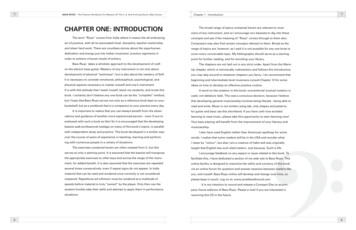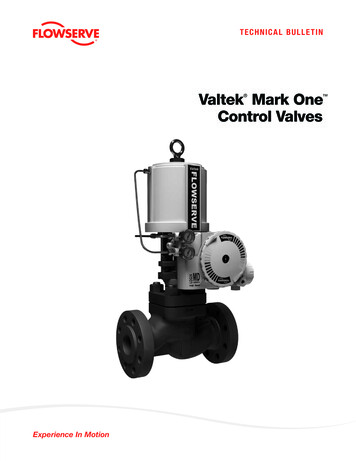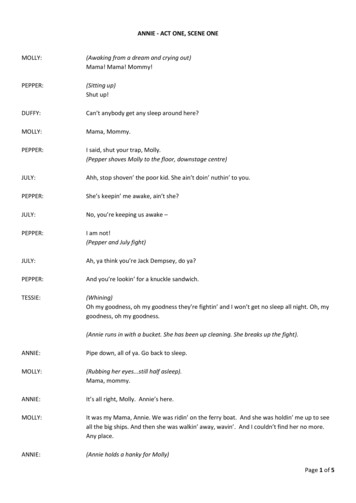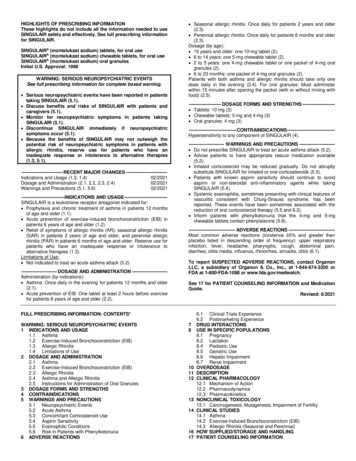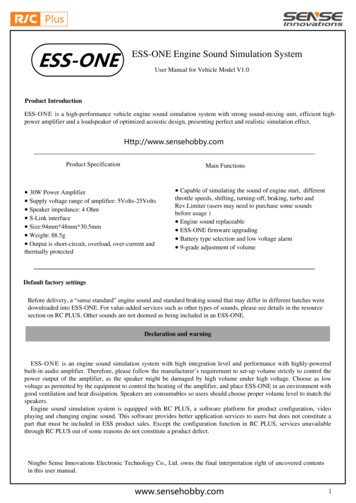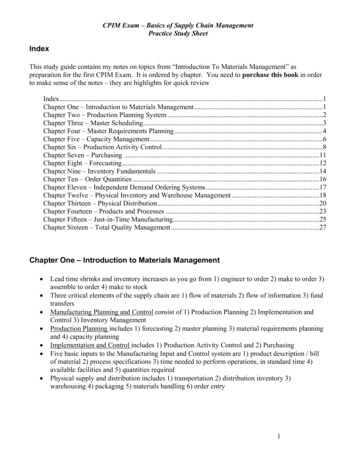
Transcription
CPIM Exam – Basics of Supply Chain ManagementPractice Study SheetIndexThis study guide contains my notes on topics from “Introduction To Materials Management” aspreparation for the first CPIM Exam. It is ordered by chapter. You need to purchase this book in orderto make sense of the notes – they are highlights for quick reviewIndex.1Chapter One – Introduction to Materials Management.1Chapter Two – Production Planning System .2Chapter Three – Master Scheduling.3Chapter Four – Master Requirements Planning .4Chapter Five – Capacity Management.6Chapter Six – Production Activity Control.8Chapter Seven – Purchasing .11Chapter Eight – Forecasting.12Chapter Nine – Inventory Fundamentals .14Chapter Ten – Order Quantities .16Chapter Eleven – Independent Demand Ordering Systems.17Chapter Twelve – Physical Inventory and Warehouse Management .18Chapter Thirteen – Physical Distribution.20Chapter Fourteen – Products and Processes .23Chapter Fifteen – Just-in-Time Manufacturing.25Chapter Sixteen – Total Quality Management.27Chapter One – Introduction to Materials Management Lead time shrinks and inventory increases as you go from 1) engineer to order 2) make to order 3)assemble to order 4) make to stockThree critical elements of the supply chain are 1) flow of materials 2) flow of information 3) fundtransfersManufacturing Planning and Control consist of 1) Production Planning 2) Implementation andControl 3) Inventory ManagementProduction Planning includes 1) forecasting 2) master planning 3) material requirements planningand 4) capacity planningImplementation and Control includes 1) Production Activity Control and 2) PurchasingFive basic inputs to the Manufacturing Input and Control system are 1) product description / billof material 2) process specifications 3) time needed to perform operations, in standard time 4)available facilities and 5) quantities requiredPhysical supply and distribution includes 1) transportation 2) distribution inventory 3)warehousing 4) packaging 5) materials handling 6) order entry1
CPIM Exam – Basics of Supply Chain ManagementPractice Study SheetChapter Two – Production Planning System Priority – what is needed, how many and when; Capacity is the capability to produce goods andservices. In the long run, they must be in balanceManufacturing Planning and Control System has five levels (sorted by level of detail):1. Strategic Business Plan2. Production Plan3. Master Production Schedule4. Material Requirements Plan5. Production Activity Control and PurchasingStrategic Business Plan 1) marketing determines product & pricing 2) Finance finds funds 3)Production meets needs through machinery & labor 4) Engineering is responsible for design.Reviewed every 6 months to a yearProduction Plan 1) quantities by product group 2) desired inventory levels 3) equipment, labor andmaterial needed 4) availability of resources needed. Planning horizon 6-18 months and reviewedmonthly or quarterlyMaster Production Schedule (MPS) is for production of individual items. The planning horizon is3-18 months out. Master scheduling is the process of making an MPS. The plans are changedweekly or monthlyMaterial Requirements Plan (MRP) is a plan for production and purchase of items in the masterproduction schedule. Purchase and Production Activity control use the MRP for controlling rawmaterials. The planning horizon is a day to a monthProduction Activity Control and Purchasing represent the implementation of the plan. Purchasingobtains material per the MRP and production carries out the tasks in the MRPSales and Operations Planning is derived from the Strategic Business Plan and is made up of aMarketing Plan that links to the Production Plan (above) and a Detailed Sales Plan that links to themaster Production Schedule (above)Manufacturing Resource Planning (MRP II) is the fully integrated planning and control system. Itcoordinates between marketing and production. It includes the sales and operations plan, the salesplan, master schedule, material requirements plan, purchasing, production activity control andperformance measuresEnterprise Resource Planning (ERP) is an accounting oriented information system for identifyingand planning the enterprise. ERP encompasses the entire company and MRP II is manufacturingIn the short term the product plan is limited by capacity. Changes can be made through overtime,build up of inventory, subcontracting and leasing extra equipmentThe production plan usually has a12 month time horizon, a few product groups, demand isfluctuating, plant and equipment are fixedThree basic strategies for making the production plan include 1) chase 2) production leveling(divide total production units by # of days for target) 3) subcontracting (make minimum demandand subcontract the rest)Level production (total forecast back orders ending inventory – opening inventory) / # ofperiodsIn a make-to-order environment, there is a backlog of customer orders2
CPIM Exam – Basics of Supply Chain ManagementPractice Study SheetResource bill shows the critical resources needed to make one average unit in the product group.This is used for resource planning. You need to determine the materials (# of units * # of materialrequired) and labor (# of units * # of hours) needed to make the plan in standard hoursChapter Three – Master Scheduling Master production schedule (MPS) 1) links production planning to what will be built 2) calculatescapacity and resources needed 3) drives the materials requirements plan 4) drives priorities formanufacturingTo build the master production schedule (MPS) you need the following information1. the production plan2. forecasts for individual end items3. actual orders received from customers and for stock replenishment4. inventory levels for individual end items5. capacity constraintsObjectives of MPS are to 1) maintain finished good inventory levels 2) make the best use of labor,materials & equipment 3) maintain inventory investment (WIP) at the required levelsDevelop a preliminary MPS, check MPS against capacity, resolve differences (this is called roughcut capacity planning)Rough cut capacity planning checks whether resources are available to support the preliminarymaster production schedule. Plan on a single product, not a group, and use the resource billFor make to stock, the MPS is a schedule of finished goods items, for make to order the MPS is aschedule of actual customer orders, for assemble to order, go to the base orderFinal Assembly Schedule (FAS) – schedule of what will be producedMPS is a plan for what production can and will do – it is not a sales forecastAvailable to Promise (ATP) is based on the MPS – portion of inventory that is not alreadycommitted and available to a customer. ATP scheduled receipts beginning inventory actualorders scheduledProjected available balance (PAB) includes a calculation for customer orders. PAB prior periodPAB MPS – greater of (customer orders or forecast demand)Frozen Zone – capacity and materials are committed to specific orders, senior mgmt approvalrequired for changes.Slushy Zone – capacity and material are committed to less extent. Tradeoffs must be met betweenmarketing and manufacturingLiquid Zone – any changes can be made to the MPS3
CPIM Exam – Basics of Supply Chain ManagementPractice Study SheetChapter Four – Master Requirements Planning Materials Requirements Planning has 2 major objectives1) determine requirements 2) keeppriorities currentIndependent demand must be forecast; dependent demand is related to the demand for other items(higher level assemblies or products)Material Requirements Planning (MRP) drives Production Activity Control (PAC) andpurchasing. MRP plans the release and receipt dates for orders. PAC and purchasing must planand control the performance of orders to meet the due datesThe Material Requirements Planning System has three inputs 1) master production schedule 2)inventory records 3) bills of materialsInventory records have 1) planning factors (header records) and 2) status of each item that changeswith every transactionBill of Material is “a listing of all the subassemblies, intermediaries, parts and raw materials thatgo into making the parent assembly showing the quantities of each required to make an assembly”.Three points1. BOM shows all the parts required to make one item2. Each part or item has only one part number3. A part is defined by its form, fit or function. If any of these change, they become new, uniqueparts (i.e. if you paint something)Multilevel bills are formed as logical groupings of parts into subassemblies, based on the way theproduct is assembled (i.e. an auto has a frame, chassis, doors, windows and engine assubassemblies)Summarized parts list contains all the parts needed to make one assembly; produced by theproduct design engineerPlanning bills are artificial groupings of components for planning purposes. They do not representbuildable products but an average productWhere-used reports give the same information as a bill of material, but gives the parents for acomponent. Wheels might be used on several models of carsPegging report is like a where used report but only shows parents for which there is an existingrequirement (rather than all parents, even those with no current production)Bills of material are used for the following purposes1. product definition – components to make a product2. engineering change control – recording changes to design of a product3. service parts – replacement parts needed to fix a broken component are determined from thebill of material4. planning- define what materials are needed to create an end product5. order entry – the order entry system usually automatically configures the order with parts andcalculates the total extended price6. manufacturing – provide a list of parts needed to make a product7. costing – method of determining direct material and a structure for recording direct labor anddistributing overheadLead time is the amount of time needed to perform an operation – it includes order preparation,queuing, processing, moving receiving and inspectingExploding is the process of multiplying the requirements by the usage quantity and recording theappropriate requirements throughout the product tree4
CPIM Exam – Basics of Supply Chain ManagementPractice Study SheetOffsetting is the process of placing the exploded requirements in their proper periods based onlead timeThe planned order release of the parent becomes the gross requirement of the componentReleasing an order means that authorization is given to purchasing to buy the necessary materialor to manufacturing to make the component (check component availability first)Scheduled receipts are orders place on manufacturing or on a vendor and represent a commitmentto make or buy. Scheduled receipts on the MRP record are open orders on the factory . When thegoods are received into inventory and available for use, the order is closed out, and the scheduledreceipt moves into on-hand inventoryNet Requirements gross requirements – scheduled receipts – available inventoryLow level code is the lowest level on which a part resides in all bills of material. Determined bystarting at the lowest level of a bill of material and working up to the partResponsibility of planner is to 1) launch (release) orders to purchasing or manufacturing 2)reschedule due dates of open (existing) orders as required 3) reconcile errors and try to find theircause 4) solve critical material schedules by expediting or re-planning 5) coordinate with othersPlanned orders are automatically scheduled by the computer. Released orders are responsibility ofthe planner. Firm planned orders can be held against changesException messages advise the planner when something needs attentionTransaction messages mean that the planner must tell the MRP software of all actions such as 1)release an order 2) schedule a receipt 3) change to the dataFeedback to the plan comes from 1) suppliers actions through purchasing 2) early or latecompletion at the factory 3) management actions such as changing the master production scheduleReducing systems nervousness of constant changes through firm planned orders5
CPIM Exam – Basics of Supply Chain ManagementPractice Study SheetChapter Five – Capacity Management Capacity is the amount of work that can be d
CPIM Exam – Basics of Supply Chain Management Practice Study Sheet Index This study guide contains my notes on topics from “Introduction To Materials Management” as preparation for the first CPIM Exam. It is ordered by chapter. You need to purchase this book in order to make sense of the notes – they are highlights for quick review


